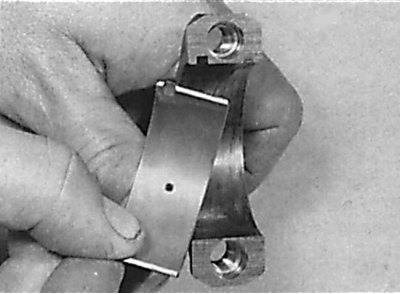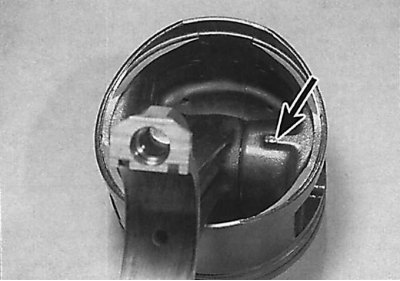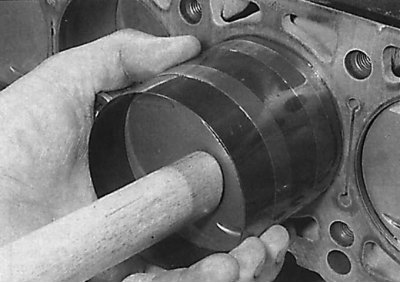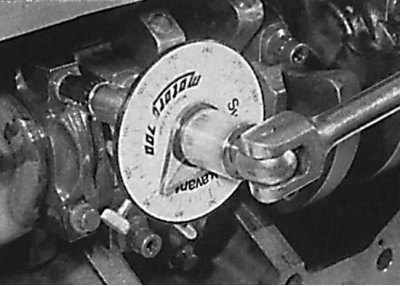Four-cylinder petrol engines
To determine the required thickness of new connecting rod bearings, it is necessary to measure the inner diameter of the connecting rod bearing, the diameter of the connecting rod journal of the crankshaft and take into account the operating clearance of the bearing. The required bearing thickness can be calculated as follows.
Example
Bearing diameter 62.51 mm
Crankshaft journal diameter 57.95 mm
4.56 mm
Bearing working clearance -0.04 mm
4.52 mm±2
2.26mm
Main bearing shells are available as spare parts in the following thicknesses.
| Inserts | Liner thickness |
| Nominal | 1.80 mm |
| Repair size 1 | 1.92 mm |
| Repair size 2 | 2.05 mm |
| Repair size 3 | 2.18 mm |
| Repair size 4 | 2.30 mm |
Six-cylinder SOHC gasoline engines
The thickness of the connecting rod bearing shells is determined in the same way as for 4-cylinder petrol engines. Consult your Mercedes-Benz dealer to determine the required bearing size.
Six-cylinder DOHC gasoline engines
To determine the required thickness of new connecting rod bearings, it is necessary to measure the inner diameter of the connecting rod bearing, the diameter of the connecting rod journal of the crankshaft and take into account the operating clearance of the bearing. The required bearing thickness can be calculated as follows.
Example
Bearing diameter 62.51 mm
Crankshaft journal diameter 57.95 mm
4.56 mm
Bearing working clearance -0.04 mm
4.52 mm±2
2.26mm
Determine the required main bearing shell thickness from the table after consulting your Mercedes-Benz dealer.
Diesel engines
To determine the required thickness of new connecting rod bearings, engines are needed. Consult your Mercedes-Benz dealer to determine the required bearing size.
Checking the operating clearance of connecting rod bearings
1. Clean the back of the bushing and its location in the connecting rod and connecting rod cap.
2. Install the earbuds in place.
3. One method, which involves having a micrometer to measure the diameter of the bores, is to install the connecting rod bearing caps, along with the shell, onto the connecting rods and tighten them to the correct torque. Measure the inside diameter of each assembled pair of bearing shells. Measure the diameter of each connecting rod journal of the crankshaft. Subtract the corresponding diameter of the crankshaft main journal from the measured bearing diameter.
4. Second (and more accurate) the method is to use a product known as Plastigage. This is a round plastic rod that is compressed between the bushing and the crankshaft journal. After removing the connecting rod bearing cap, the deformed plastic rod is measured with a special gauge, which is included in the Plastigage kit. The procedure for using Plastigage is as follows.
5. Install connecting rods with liners without lubrication on the crankshaft. The crankshaft journals and liners must be perfectly clean and dry.
6. Cut off a few pieces of the plastic Plastigage rod (they should be slightly shorter than the width of the connecting rod bearings) and install on each crankshaft journal.
7. Install the covers with the bottom liners and tighten the mounting bolts to the required torque. Do not rotate the crankshaft while measuring clearance with the Plastigage method.
8. Unscrew the cover of the insert attachment, remove it and attach a scale ruler to the deformed plastic rod. By comparing the width of the deformed plastic rod with the reference width on the scale bar, determine the amount of gap.
9. Finally, carefully clean the traces of Plastigage - the material from the liners and the crankshaft.
Installing pistons with connecting rods
Installing the connecting rod cap

Piston crown on 6-cylinder DOHC gasoline engines

On 6-cylinder DOHC gasoline engines, the boss under the piston crown must be on the flywheel side.
Installing a piston in a cylinder using a block of wood or a hammer handle

Tightening the connecting rod cap bolts by turning them to a certain angle

1. Clean the back of the connecting rod bearing and its location in the connecting rods and connecting rod caps. Install the connecting rod bearings and connecting rod caps (see fig. Installing the connecting rod cap).
2. Lubricate the pistons and piston rings and position the piston ring locks as required.
3. Piston installation must begin with the first cylinder. Compress the piston rings on the piston with a piston ring compressor.
4. Insert the piston with the ring compressing tool into the top of the first cylinder. In this case, the arrow on the piston bottom should be directed towards the drive chain, and the marks on the connecting rods and connecting rod caps should be in the same position as before removal (see fig. Piston crown on 6-cylinder DOHC gasoline engines). Using a block of wood or a hammer handle, push down on the piston and press it into the cylinder.
5. Check the alignment of the bottom head of the connecting rod with the neck of the crankshaft. If necessary, tighten the piston with a connecting rod and install the lower head of the connecting rod with an insert on the crankshaft journal. Screw in bolts of fastening of a cover of a rod the demanded moment.
6. Install the remaining pistons with connecting rods in the same way.
7. Further installation is carried out in the reverse order of removal, taking into account the following points.
8. On 4-cylinder petrol engines, install the oil pan and cylinder head.
9. On 6-cylinder SOHC gasoline engines, install the oil pump, oil pan and cylinder head.
10. On 6-cylinder DOHC gasoline engines, install the oil pump, oil catcher plate, oil pan and cylinder head.
11. On diesel engines, install the oil pump, oil catcher plate, oil pan and cylinder head.
